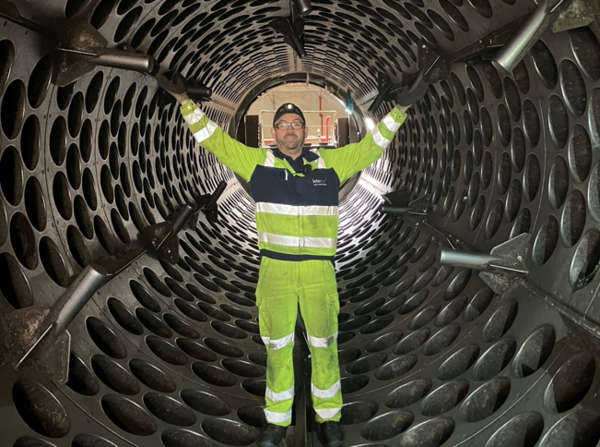#InBrief: What do we use drum sieves for? Explained by Alexander Jakob
Once the yellow bags have been opened in the shredder, the drum sieve sorts the contents of the bags by size. This means that all materials, regardless of their ‘grain size’, as it’s termed in the industry jargon, enter the sieve, but only the materials that pass through the sieve are fed into the sorting process, which ensures that this can run at high rates of throughput. To save on space requirements, our sieve is not flat but is shaped into a drum.
As the drum sieve operates according to mechanical principles, this makes it a very simple but extremely effective piece of equipment. The drum sieve has some rather impressive dimensions: with a drum length of 12 metres and a diameter of 3 metres, the sieve can handle a maximum material throughput of roughly 35 tonnes per hour. Although it is the biggest machine in the whole plant, it is also the quietest.
Inside the drum sieve, ‘spines’ are attached that untangle and separate the LWP material. This is necessary because the material is pressed together hard by the crusher truck and now needs loosening up. The spines are attached at different angles, to avoid the formation of ‘plaits’, i.e. continuous and contiguous strips made up of netting, videotapes or packaging strap materials. The ‘paddles’ located inside the drum sieve move the material upwards, which increase the sieve surface area.
Once a year, the impellers that support and drive the drum sieve must be replaced. And that’s it – making the drum sieve very low-maintenance compared with other equipment. Every ten years, we need a new machine – with a price tag of EUR 300,000.
The drum sieve is only ever operated by trained personnel. One of these people is Alexander Jacob.
A metalworker and design technician by trade, Alexander is employed by Interzero Plastics Sorting in Walldürn, where he works as a maintenance technician in our sorting plant. Since 2008, he has been keeping the technical systems at the plant running smoothly and replacing faulty parts before problems can occur. His team admires him for his helpfulness and patience, which is particularly the case when onboarding new colleagues. And his tech skills also come in handy for his hobbies, especially car tuning, where he can really let his imagination run wild.




![[Translate to English - Englisch:] [Translate to English - Englisch:]](/fileadmin/_processed_/1/4/csm_230606-AGA-Tridi-Indonesia-PET-recycling_e3dcd2ad90.jpg)